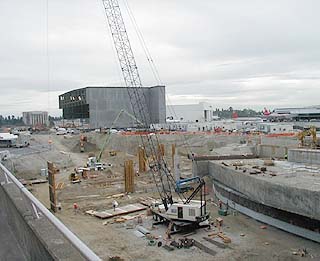|
Subscribe / Renew |
|
|
Contact Us |
|
| ► Subscribe to our Free Weekly Newsletter | |
| home | Welcome, sign in or click here to subscribe. | login |
Construction
| |
 |
June 10, 2004
Keeping a complex project on track
Magnusson Klemencic Associates

Greene
|
The challenge: Moving existing operations, demolishing facilities, and constructing new facilities without interrupting the day-to-day flow of over 26 million air passengers and 354,800 aircraft operations each year.
The only possible solution: Really complex phasing.
Our job as civil engineers was to ensure that transportation and utility infrastructure systems all ended up where they needed to be when they needed to be there. All told, over 3.5 miles of new below-grade infrastructure were required for Sea-Tac's South Terminal expansion project (STEP).
The complexity of STEP required over 90 sheets of phasing drawings, with 32 of those drawings focused on civil systems alone. (This was in addition to the 70 civil drawings produced for actual project design.)
In contrast, a single phasing drawing is sufficient for a typical project, and the contractor determines the construction sequence as part of its “means and methods.”
An unusual step

Photo courtesy of MKA
Sea-Tac’s South Terminal expansion spawned a series of other airport projects that were needed to keep the expansion on schedule. One project was to demolish a Delta hangar to make room for a Northwest hangar. |
For STEP, the Port of Seattle took the unusual step of assigning the design team responsibility for defining phasing in the bid set. This enhanced the contractors' understanding of STEP and ensured that bids submitted were for the project the Port actually wanted to receive.
The drawings phased construction around eight critical milestones over a three-year period. Without the drawings, construction would surely have taken longer and potentially led to costly change orders for the Port.
From the perspective of Magnusson Klemencic Associates, designing STEP actually involved designing multiple projects simultaneously, including some that on the surface appeared to have no direct relation to STEP.
For example, some of MKA's early work related to STEP was to design a Delta air cargo facility. Why? A carefully timed sequence of projects at the south end of Sea-Tac had to be completed on very specific dates to make sure STEP was completed on schedule. Even a very simplified listing of critical path items was daunting:
- Begin design of STEP;
- Design and build a new Delta ground-service equipment building to accommodate functions housed in the existing Delta hangar;
- Demolish the Delta hangar to make room for a new Northwest hangar;
- Design and build the Northwest hangar, with provisions for future tunnel excavations directly below the building (for the proposed state Route 509 south link);
- Design and build a new outbound baggage building to accommodate operations currently housed in the Pan Am hangar;
- Design and construct a new South Satellite modular building to house personnel currently in Concourse A;
- Demolish the old Northwest hangar, Pan Am hangar, Northwest flight kitchen and a portion of existing Concourse A to make room for STEP; and
- Begin construction of STEP.
Simultaneous efforts
Again, it was the sequential completion dates of these tasks that drove schedule, requiring carefully timed, simultaneous design efforts on multiple pieces. Some pieces were not directly associated with STEP but instead were undertaken by the Port and other airport tenants. In those cases, coordination was needed not only with STEP management but also other stakeholders.
As with all projects, many critical path items had to occur at the same time, start at the same time or end at the same time. Needless to say, determination of phasing was as critical as design itself.
Even activities off airport property affected STEP phasing. For example, cruise passengers are transported to and from the airport via coach buses during cruise season, which runs April through October. The Port mandated that this activity remain uninterrupted. What may seem like a minor activity was critical to STEP phasing.
A review of some additional civil challenges further demonstrates the atypical nature of STEP:
Working upside down
Traditionally, gravity-dependent utilities (storm drain, industrial waste, and sanitary sewer) are installed from the downhill point of connection uphill to the end of the system or connection. The phasing for STEP dictated that the utilities on the airside of the new concourse coincide with the flow of construction of the new concourse. This meant a reverse installation from upstream to down, requiring additional temporary connections and complicated cutovers.
3.5 miles of piping
Coordination, installation and cutover of below-grade utilities associated with STEP was critical to minimize outages for other operating areas of the airport.
While over 3.5 miles of storm drain, industrial waste, sanitary sewer and water piping were installed, close to the same amount was removed because it was outdated or redundant. (A typical downtown Seattle project requires less than 500 feet of such utilities.)
For STEP's 24/7 operations, it was necessary to preserve some portions of existing underground infrastructure longer than normal, to minimize interruption of services.
Not-so-simple phasing
The phasing design for STEP went well beyond a simple, “Do A, then B, then C.”
For example, phasing drawings for the ground transportation lot demonstrated to the contractor: (1) the earliest the work could be started, (2) when completion was required, (3) how the work related to other work taking place in that phase, (4) other items that had to be accommodated, started or completed prior to the work, and (5) items that could take place after the work.
And that was just one piece of the STEP puzzle.
All airplanes, all the time
The demands of a 24/7 facility also required special consideration. In one case, a heavily used, manned truck access gate (Gate E45) had to be moved because it was going to end up directly in the path of airplanes taxiing to the new terminal.
However, because of the gate's critical nature — providing primary access to the airport's south end secure area — the old gate had to continue working while the new gate was built.
Project execution went amazingly smoothly, given STEP's complexity and potential for conflicts.
Very few civil requests-for-information were received, and most foreseeable situations for change were considered and addressed by the design team in advance. STEP is built proof that carefully thought out and documented phasing can save considerable time, money and headaches during construction.
Rita Greene, civil managing principal for STEP, is a principal at Magnusson Klemencic Associates, specializing in complicated site developments.
Other Stories:


